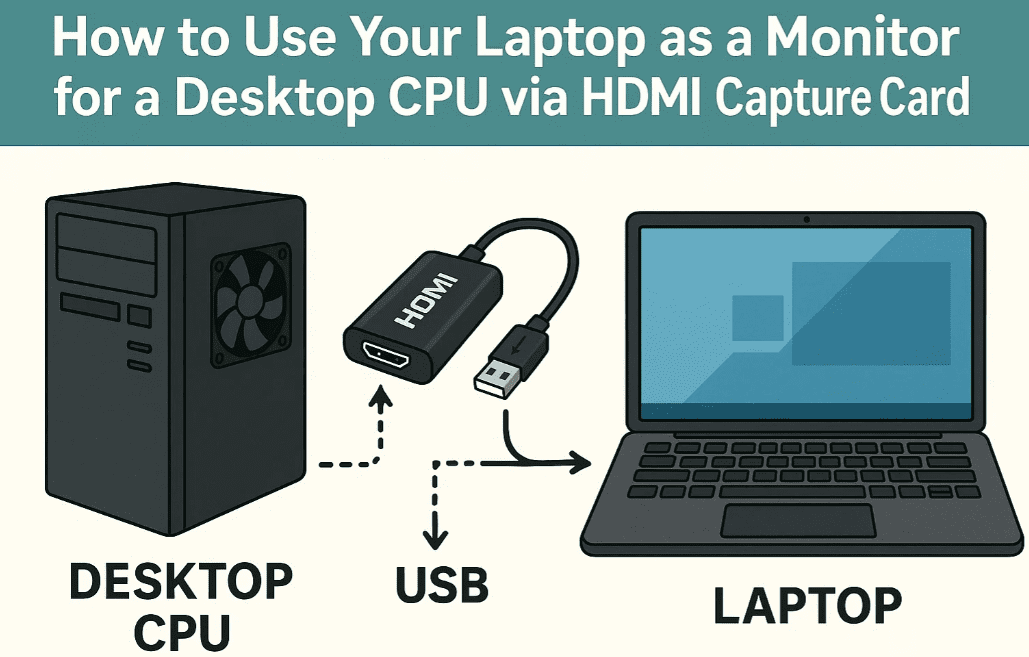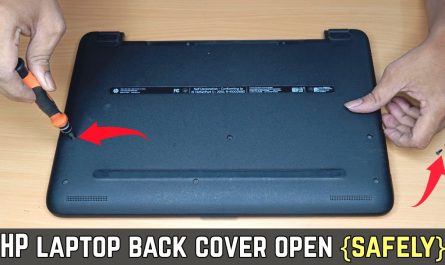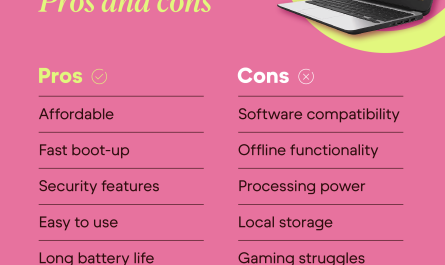Ever found yourself wishing your laptop screen could double as a monitor for another device? Maybe you want to extend your desktop without splurging on a pricey second monitor or use your laptop’s large display for a gaming console or media streamer. So, can you actually use your laptop as a monitor? The short answer is: sometimes yes, sometimes no, depending on your hardware and software.
Let me walk you through everything you need to know, from whether your laptop supports it, what gear and programs you’ll need, to how to set it all up. By the end, you’ll know how to make this happen without pulling your hair out.
Can I Use My Laptop as a Monitor for Another Device?
The Big Myth: Laptops as Video Input Devices?
Here’s the thing that trips up most people: laptops generally do not support video input via their HDMI or DisplayPort connections. Those ports are designed to send video out to an external monitor, not receive a signal in from another device. So, if you plug your gaming console or another PC into your laptop’s HDMI port, nothing will show up because it’s not built to process incoming video.
This is a big pain point and often causes confusion. Many expect laptops to act like giant external monitors—you know, like plugging in an HDMI cable and voilà—but that’s almost never the case.
Exceptions?
- Some specialized laptops come with video input ports (rare and usually on gaming or professional machines).
- Using a USB-C port that supports DisplayPort Alternate Mode might allow video input, but again, this is very uncommon.
If your laptop doesn’t have these rare features, you’re not completely out of luck. There are software and hardware workarounds that let you use your laptop screen wirelessly or via network cables.
What Software or Hardware Do I Need to Use My Laptop as a Monitor?
Since direct plug-and-play usually won’t work, you’ll need to explore solutions that use your network or USB connection.
Option 1: Using Software Solutions (Wireless or Wired)
Several apps let you stream video from another device to your laptop over Wi-Fi or Ethernet. The laptop displays the remote device’s screen inside a window or fullscreen. This is the most common method for turning your laptop into a “second monitor” for another PC or phone.
Popular software includes:
| Software | How It Works | Price | Use Case |
|---|---|---|---|
| Spacedesk | Streams video over LAN or Wi-Fi | Free | Windows PC as secondary display |
| Deskreen | Converts your laptop into a wireless display | Free & Open Source | Works on Windows, Mac, Linux |
| Windows Projecting to this PC | Built-in Windows 10 feature to project another Windows PC screen | Free | Windows PCs only |
| Duet Display | Streams video over USB or Wi-Fi | Paid | Mac or Windows as secondary display |
Option 2: Using Hardware Capture Devices
If you want to connect gaming consoles, cameras, or other HDMI sources, a video capture card is your best bet. This gadget plugs into your laptop via USB and takes the HDMI input from your external device.
Example:
- A capture card like the Elgato HD60 S plugs into your laptop’s USB port.
- Your gaming console HDMI cable plugs into the capture card.
- The capture card streams the input video to your laptop using software like OBS Studio.
This method lets you see the external device’s video on your laptop screen but with some unavoidable latency depending on your capture device and settings.
Are There Any Limitations or Compatibility Issues?
Hardware Limitations
- No HDMI input on most laptops: You can’t just plug your console or desktop directly.
- USB-C ports: Even if you have USB-C, they rarely support video input.
- Performance: Streaming over Wi-Fi risks lag or pixelation if your network isn’t solid.
Software Limitations
- Latency: Wireless solutions almost always have delay—sometimes 50 to 200 milliseconds. Not ideal for twitch gaming but fine for extending desktops or watching movies.
- Display quality: Depending on your network speed and compression, video quality may drop.
- Compatibility: Some apps only work if both devices run the same OS (like Spacedesk is Windows-only).
Real-Life Example
Imagine you want to play your Xbox on your laptop screen. Direct HDMI won’t work because your laptop can’t take HDMI input. Using a capture card lets you see the Xbox feed, but expect 1-2 seconds of lag. For casual gaming or viewing, that’s okay. For fast-paced games, not so much.
How Do I Set Up the Connection Between Devices?
Let’s get into the nitty-gritty. I’ll guide you through the three main scenarios:
Scenario 1: Windows Laptop as a Second Monitor for Another Windows PC (Using Spacedesk)
If you want to extend your main desktop onto your laptop screen, Spacedesk is a fantastic free tool.
Step 1: Install Spacedesk
- On your main PC (the device sending video), install the Spacedesk DRIVER from spacedesk.net.
- On your laptop (the receiving device), install the Spacedesk VIEWER app.
Step 2: Connect Both Devices to the Same Network
Make sure both computers are on the same Wi-Fi or LAN network.
Step 3: Open Spacedesk Viewer on Your Laptop
It should automatically detect your main PC. Click to connect.
Step 4: Adjust Display Settings
On your main PC, go to Display Settings and configure the laptop screen as an extended display.
And voilà, your laptop is now a second monitor!
Scenario 2: Mac or Windows Laptop as a Second Monitor (Using Duet Display)
Duet Display works over USB or Wi-Fi and supports Mac and Windows.
Step 1: Purchase and Install Duet Display
Download and install Duet Display on both your main device and laptop.
Step 2: Connect Devices
Plug your laptop into your main computer via USB or connect via Wi-Fi.
Step 3: Launch Duet Display
Your laptop will act as a second display instantly.
Note: Duet costs about $10-$20 but offers much smoother performance and less lag than many free options.
Scenario 3: Using a Capture Card for Gaming Consoles or External HDMI Devices
Step 1: Buy a Capture Card
Get a USB capture card compatible with your laptop, such as the Elgato HD60 or an affordable generic version.
Step 2: Connect HDMI Source to Capture Card
Plug your gaming console or camera HDMI cable into the input port on the capture card.
Step 3: Connect Capture Card to Laptop
Plug the capture card into your laptop’s USB port.
Step 4: Open Capture Software
Open OBS Studio or the software that came with your capture card.
Step 5: View External Device on Laptop
Your laptop will display the HDMI input within the software window.
Heads up: Expect slight latency and quality depending on capture card specs.
Troubleshooting Common Issues
| Problem | Possible Cause | Fix |
|---|---|---|
| Laptop not detecting main device | Devices not on same network or firewall blocking | Ensure same Wi-Fi network; disable firewall or allow app permissions |
| Laggy or pixelated display | Slow network or poor USB connection | Use wired Ethernet or USB; reduce resolution |
| No video input from HDMI source | Laptop HDMI port is output-only | Use capture card instead |
| Software crashes or freezes | Outdated drivers or incompatible OS | Update drivers; check app requirements |
FAQs: Quick Answers to Your Burning Questions
Q: Can I use my laptop’s HDMI port as an input?
No, almost all laptop HDMI ports are output-only. You need software streaming or a capture card for input.
Q: Will wireless solutions work for gaming?
Not recommended for fast-paced games due to latency. Wired or capture card options are better.
Q: Is it possible to use a Mac laptop as a second monitor?
Yes, with apps like Duet Display or Deskreen.
Q: Does using my laptop as a monitor affect battery life?
Yes, expect higher CPU and battery usage, especially with streaming software.
Final Thoughts
Using your laptop as a monitor isn’t as straightforward as plugging in a cable because of hardware design. But if you’re willing to use software like Spacedesk or Duet Display, or invest in a capture card for HDMI devices, it’s definitely doable.
Just remember: your laptop’s HDMI port won’t accept video input. If you’re looking to extend your desktop screen or mirror another PC, software streaming works great. For gaming consoles or cameras, get a capture card.
So next time you need an extra screen and don’t want to buy a new monitor, give these methods a shot. You might be surprised how handy your laptop can be!
References
[1] According to Spacedesk (https://spacedesk.net), their software lets you easily extend your desktop to a laptop over a network.
[2] Duet Display info (https://www.duetdisplay.com) highlights its USB/wireless second monitor capabilities for Mac and Windows.
[3] Elgato HD60 S product page (https://www.elgato.com/en/gaming/hd60-s) notes latency and capture card applications for video input.
[4] Microsoft Docs (https://docs.microsoft.com/en-us/windows/projecting-to-this-pc) covers built-in Windows projection features for using a laptop as a display.
If you want me to walk you through any step in more detail or troubleshoot your setup, just ask!




